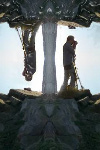
Cut Beeches
Bianditz, Gipuzkoa, Basque Country, Spain
April 2, 2011, 12:17 hours (local time)
© 2011 Iñaki Rezola, All Rights Reserved.
C'est pourquoi ces arbres ne gardent plus la forme de colonne des hêtres ordinaires, ils ont plutôt l'air d'un vieux candélabre. Ces arbres poussent plus à l'écart les uns des autres, ce qui permet à la lumière d'arriver jusqu'au sol, et à l'herbe de pousser pour nourrir le bétail, profitant des deux resources en même temps.
Aujourd'hui que l'industrie du fer n'a plus besoin de bois personne ne coupe plus les branches. Ces bois disparaissent peu à peu et leur monde avec, en même temps que les derniers gens qui possèdent encore pleinement les connaissances et les sécrets techniques qui produisaient ces bois si féeriques.
Un project en cours pour préserver la beauté et l'écologie de ce type de bois humanisé compte avec la collaboration du programme européen LIFE.
In the mountains of the Basque country there are some very curious woods. Trees used to have their trunks cut at about 2 meters high so they would push a lot of branches that were then cut for wood without having to kill the tree. Wood was in great demand at the time due to the many forges in the area.
That's why these trees don't have the regular column-shape beeches usually have, they're more like an old chandelier. This results in trees growing less thickly, so light is allowed in and grass can grow making it possible to have cattle and wood, both resources, at the same time.
Nowadays iron industries don't need wood and nobody cuts the branches anymore. So these woods are gradually disappearing along with their world and the people who fully possess the knowledge and skills involved.
The European LIFE programme is collaborating to preserve this unique kind of humanized wood.
Lat: 43° 14' 47.33" N
Long: 2° 49' 42.07" W
Elevation: 660 (appr.)
Precision is: Medium. Nearby, but not to the last decimal.
Por eso estos árboles no tienen la forma de columna habitual de las hayas, algunas parecen candelabros. Por ello los árboles crecían más distanciados, permitiendo a la luz llegar hasta el suelo y que la hierba creciera para alimentar al ganado. De esta forma podían explotarse ambos recursos simultáneamente.
Hoy en día la industria metalúrgica no necesitan madera y nadie poda las ramas. Así que estos bosques están desapareciendo gradualmente a la vez que su mundo y los últimos poseedores del conocimiento y las habilidades implicadas.
El programa europeo LIFE colabora en los esfuerzos por preservar este tipo de paisaje y de bosque humanizado.
Pago motz baso hauetan argiak lurreraino iristeko parada gehiago zuen, eta ardiak behorrak eta ahuntzak bertako belarraz elika zitezkeen, bi errekurtsoak batera ekoizten zirelarik.
Burdinolik ez gaur egun, pago egurraren eskaera jeitsi zen eta horrekin batera pagoak moztearen ohitura. Pago hauek pixkanaka desagertzen ari dira, moztearen teknika eta abileziarekin batera. Bainan ez erabat.
Gizakiak moldatutako baso mota eder honen etorkizuna bermatzekotan europear LIFE programarekin elkarlana ari da egiten.


 Tap or click the zoom icon in the bottom right corner of the picture to switch between in-page and fullscreen view
Tap or click the zoom icon in the bottom right corner of the picture to switch between in-page and fullscreen view